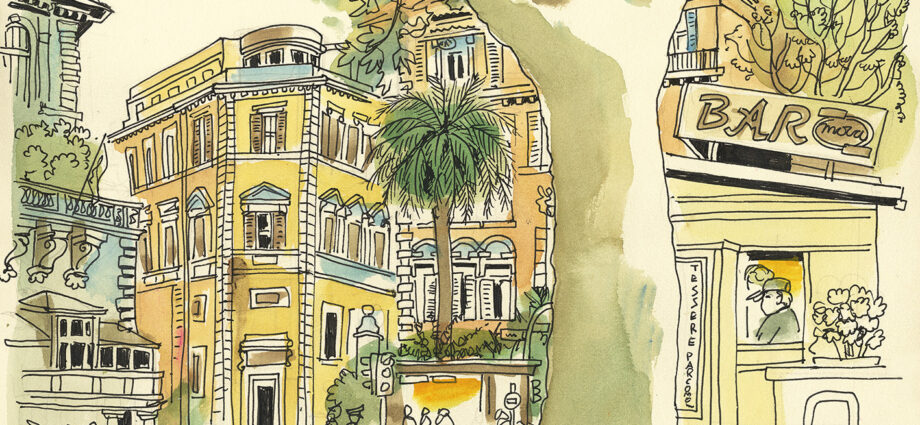As part of our dedication at Pedestrian Space to feature art from around the world, we have established a Friday Artist Feature, in which every week we feature an artist who often depicts images of urbanism, built environment and cityscapes in their work
This week we feature London based Jane Smith, a practising artist and illustrator for around 35 years now. Jane works with a wide range of clients as well as exhibits and sells her work both locally and online. Her work includes prints, sketches and watercolours of local architecture, street scenes and cityscapes as well as thousands of pen and watercolour sketches from her travels. She also enjoys printmaking; mainly linocut and wood engraving as well as line drawing, and works within all these disciplines. Her illustration work has covered many other subjects too although maps and architecture feature prominently.
*All illustrations featured by Jane Smith
“My favourite kind of day involves being in a city, getting up early, having coffee and breakfast, then walking, walking and walking, stopping to sketch when I see an inspiring view.”
Jane Smith
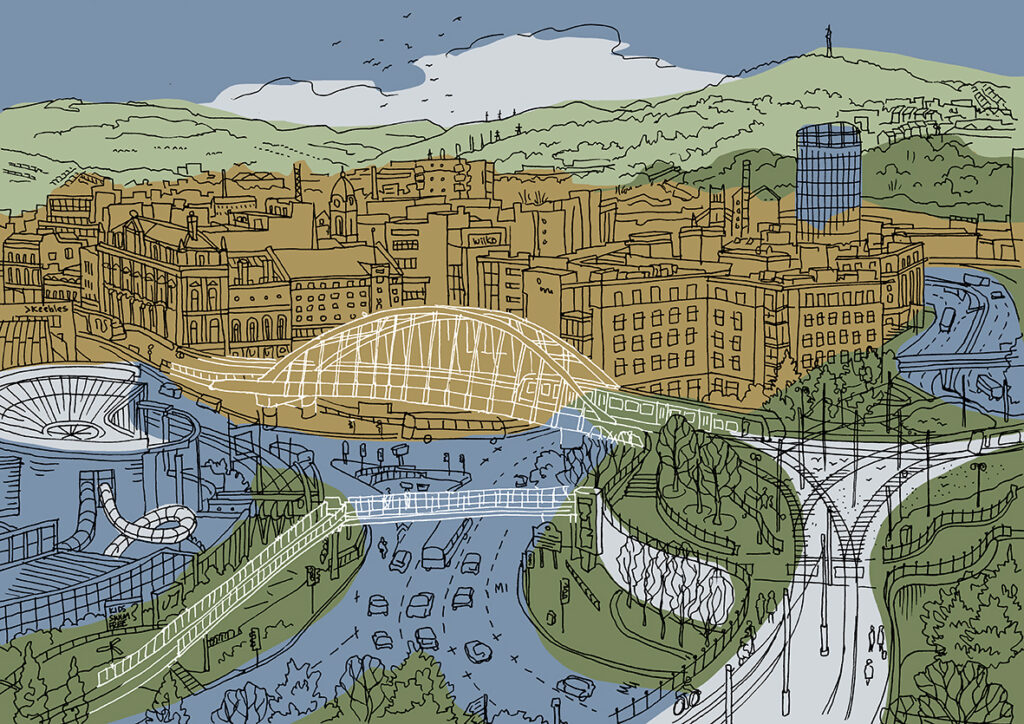
Pedestrian Space: What cities inspire you and your work?
Jane: I live and work in London. There’s plenty here to inspire me although I have done lots of travelling in the past, always with a sketchbook. It’s very hard to choose a favourite city but San Francisco, Naples, Marseille, Edinburgh and Sheffield all rate highly in my opinion. I think that this is partly because they’re hilly, which is always an attraction to me as it gives interesting views and if they’re by the sea that’s an added bonus.
Pedestrian Space: What is the relationship between the city and your art? How does urbanism influence your work?
Jane: There are many reasons why I am attracted to urban surroundings in relation to my work.
I like the shapes made by the endless varieties of buildings in relation to each other as well as in relation to the streets, settings and people around them. The constant change and energy of the city are inspiring. There is usually a wealth of detail to look at; clues as to the layers of history underneath.
Watching people coming and going about their daily lives can be entertaining too, and it gives me a chance to sharpen up my figure drawing. It’s fun to draw them quickly, capturing character and energy rather than worrying about accuracy.
From a practical point of view, there is usually a choice of places to sit and sketch from, whether a cafe seat, a step or a wall. Of course it’s even better with food and drink on hand. If the weather is unsuitable for outdoor sketching, there’s the choice of finding a cafe or public building with a window view, or of drawing interiors instead.
My favourite kind of day involves being in a city, getting up early, having coffee and breakfast, then walking, walking and walking, stopping to sketch when I see an inspiring view. Sometimes I set off without plans and just wander, seeing where I end up, and at other times I have a destination in mind, but enjoy unexpected things along the way there and back.
Pedestrian Space: What mediums do you work with?
Jane: When I am out sketching I usually work with waterproof drawing pens and then add watercolour, as they are convenient to carry and relatively quick to use. I generally start with rough pencil lines, do a more detailed ink drawing, rub the pencil out then add a watercolour wash afterwards. Sometimes I just use pencil or ink on its own.
When working at home or in my studio I scan much of my line work then colour and manipulate it digitally. When I have more time at home I also enjoy relief printmaking, especially linocut and wood engraving, using either specialist paper or salvaged pieces in various colours that I find on my wanderings.
Pedestrian Space: We were initially drawn into your work through your depictions of the built environment. Exploring your site, it is clear that many different cities are represented in your architectural illustrations. Can you share more about this?
Jane: Although I work from my own photos for some of my London drawings as time is often too short, when I am travelling I nearly always draw on location. Depending on the length of time that I plan to stay in a particular town or city, I will have a very rough idea of how much time I can devote to sketching. This can mean the difference between a larger, detailed drawing, full of life and activity, or a very quick, small pencil sketch. I particularly like markets and small streets with lots of interesting independent cafes and shops, where there is usually somewhere to sit, a plentiful supply of food and drink, as well as endless subject matter.
It often leads to a ‘layered’ sketch, with people in the foreground, stalls in the middle distance, then buildings in the background, possibly with landscape beyond that. This view of a market in Marseille demonstrates that.
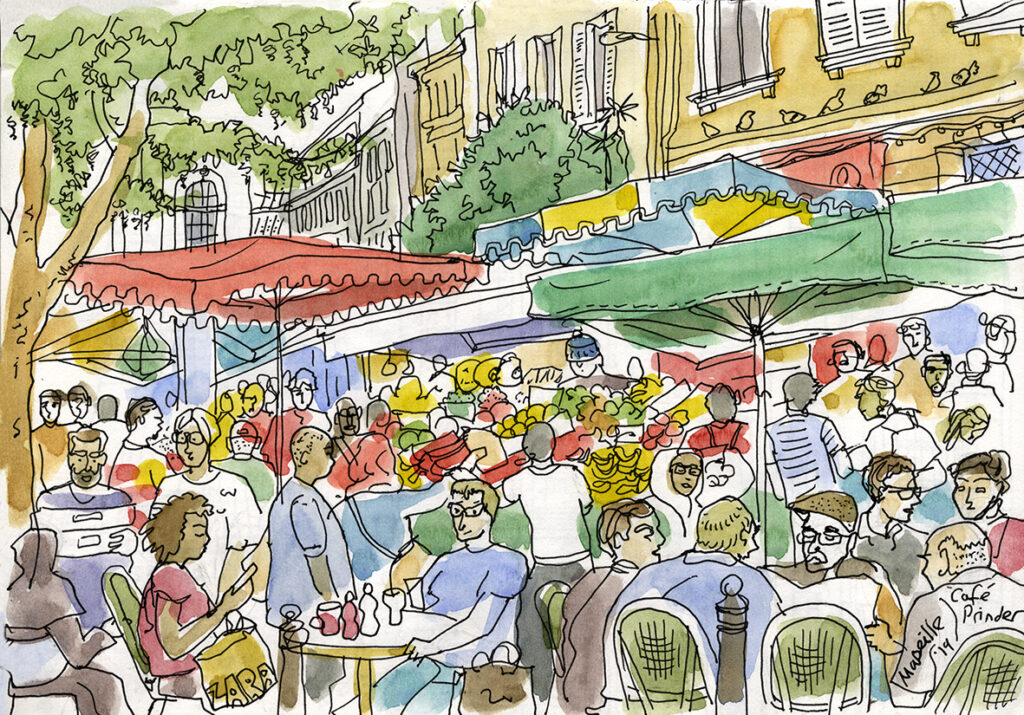
The particular sketch (below) of a scene near the River Tiber in Rome has always been one of my favourites. The buildings and tree create a structure, then the cafe, motorbikes and policemen populate the scene. I also like the warm ochre colours which are found in many parts of Italy.
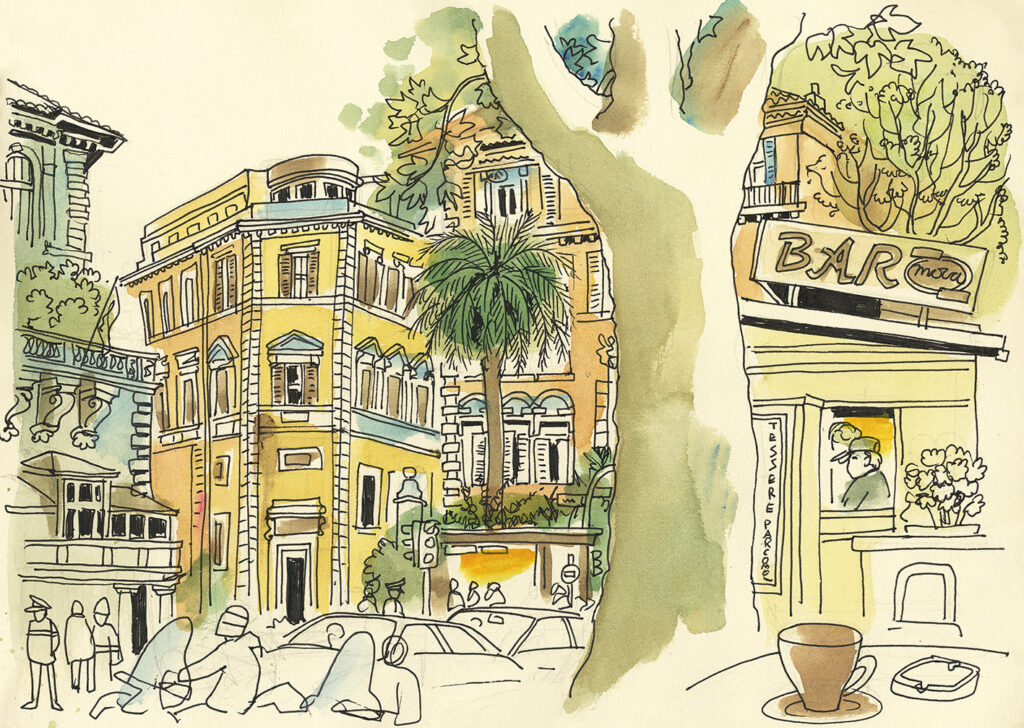
I wanted to show both the distance and the hilly nature of San Francisco in this tall, thin drawing of the North Beach area. By using ink lines for the foreground, then pencil lines for the elements further away, I created a sense of perspective. The road sweeps downhill away from the viewer, before rising again steeply in the distance. The signs and typography on the building add vintage character too.
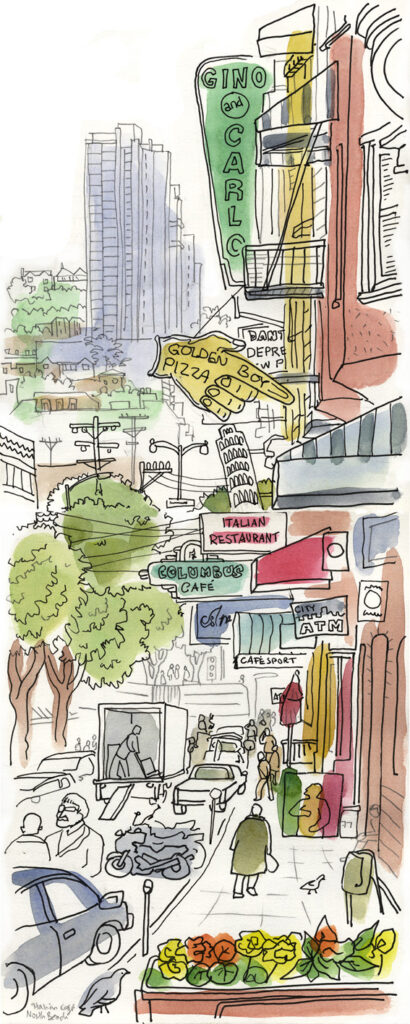
“There’s something special about treating myself to a lovely meal in the evening after a long day’s walking, and an early night, already feeling excited about the next day’s walk.”
Jane SmiTh
Pedestrian Space: Your illustrated maps are wonderful! How did you get into this type of illustrated work?
Jane: I started working on illustrated maps some time ago when the Guardian newspaper commissioned me to do a map to illustrate a particular article. After this, I started to receive more commissions from them as well as from other newspapers, magazines and publications. I realised that there was a demand for map drawings so I started to promote them as a specialty. To this day I receive commissions from wide and varied sources, many featuring local history, and have just completed my most recent one.
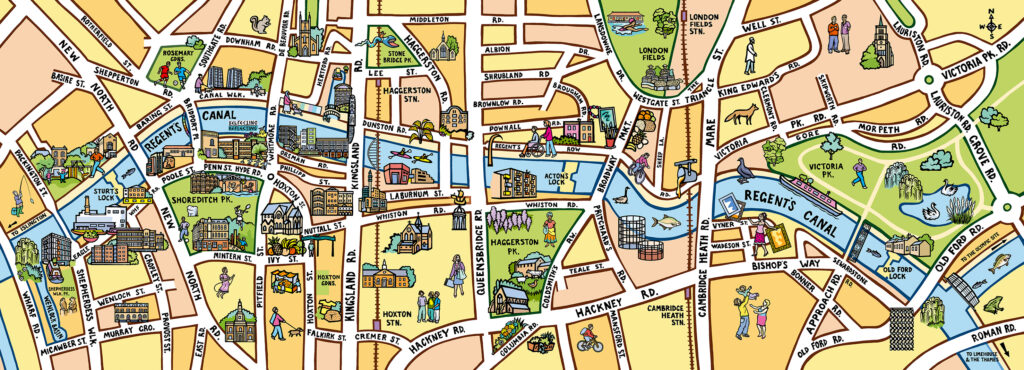
Pedestrian Space: Can you share the story behind getting commissioned for Healthy Walking Map for Shoreditch and the experience of creating it?
Jane: This map was commissioned by the Shoreditch Trust in collaboration with the NHS and Local Authorities in east London with the purpose of encouraging people to walk, cycle and be healthier and more active in their local area. Illustrated points of interest including architecture and nature among other things help people appreciate what’s on their doorstep. This map, concentrating on a section of the Regent’s Canal, is one of a series of three that feature different areas of east London. It was available free from health centres, clinics etc.
Pedestrian Space: Is there a relationship between walking and your art in general?
Jane: Definitely; I find walking helpful for creativity in lots of ways.
It often gives me chance to think and to develop ideas in a more natural, relaxed way than when at my desk or computer. The feeling is that there’s less pressure somehow. A soothing feeling arises from the steady rhythm of walking, and there’s usually something new to look at, however small, and I’m kept in tune with the changing seasons. Physically too, it keeps me fitter, which is obviously helpful, along with the fresh air.
When walking around my local area, it’s nice to bump into friends and neighbours. Sometimes while walking I see views that I think of as ‘perfect’ compositions. I take photos and often work them up into drawings to turn into prints. This view of the National Theatre and Shard in London is one such example, spotted while walking over Waterloo Bridge.
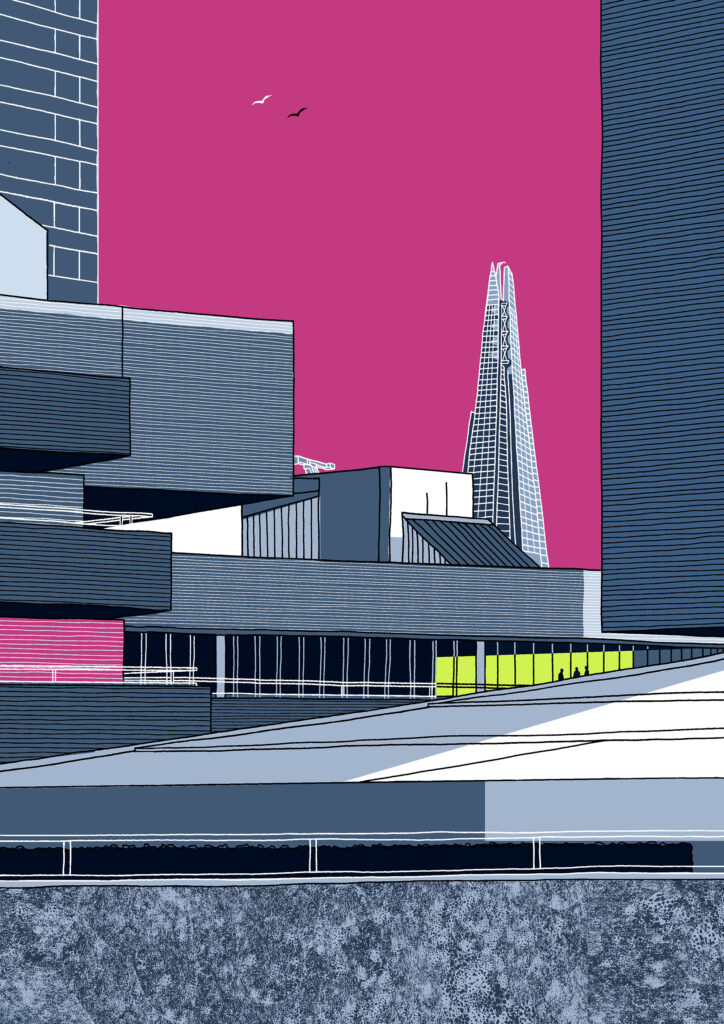
If walking in other towns and cities, it’s more a journey of discovery, the focus being more on seeing new things and stopping to sketch or take photos. If I don’t have time on that occasion I make a note to revisit with a sketchbook. Sometimes I will see something particularly interesting from a bus or train, and try to remember where it is then return on foot or bike to have a better look.
Pedestrian Space: How do you move around the city and what is your favourite mode?
Jane: In London I usually walk or cycle for shorter journeys, or go by tube, train or bus otherwise. There are plenty of quiet side roads, so it’s easy to avoid heavy traffic. I very rarely take taxis, and although I can drive, I haven’t had or driven a car for years. Another advantage to urban life is the wide choice of public transport. If travelling by bus, if it’s a double-decker, I try to find a seat near the front at the top. It provides more interesting views. This painting of a building site in Folgate Street (7) in London’s East End was inspired by a view that could only be spotted from the top deck of a bus. I also enjoy the tube if it’s not too crowded, and have long had a fascination with London Underground architecture, signage and details, whether from the early twentieth century or the 1930s.
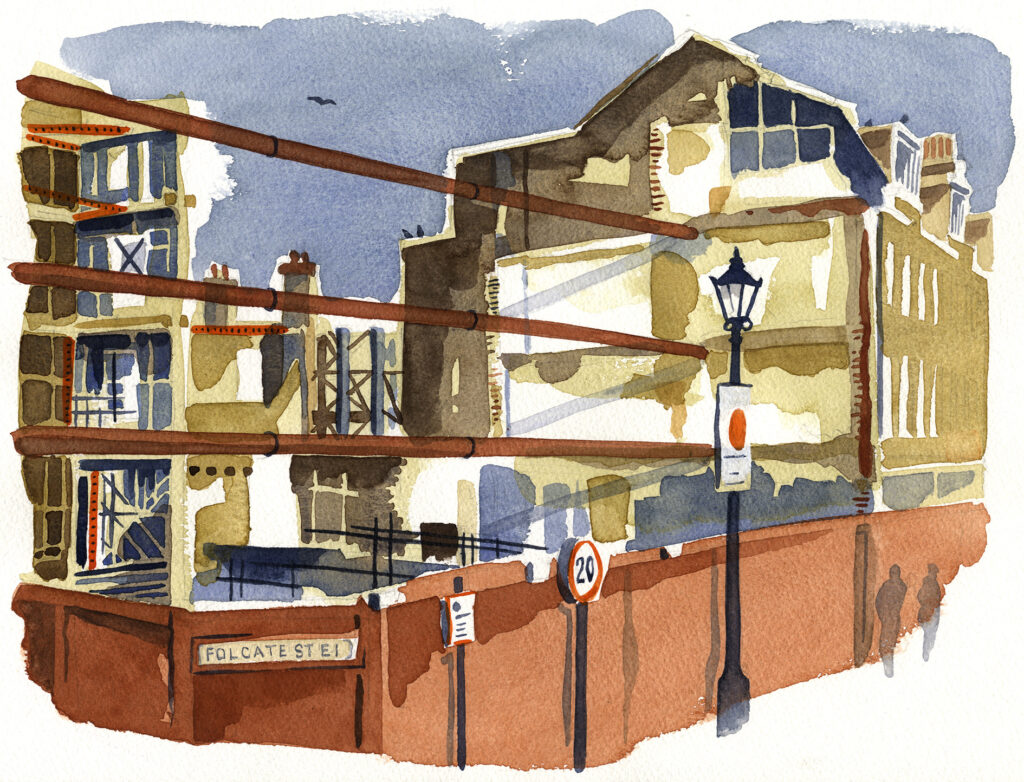
I especially like the outlying Art Deco stations on the Piccadilly and Central lines.
When in other cities I try to walk as much as I can, using public transport only when I need to. There’s something special about treating myself to a lovely meal in the evening after a long day’s walking, and an early night, already feeling excited about the next day’s walk.
Pedestrian Space: What is your favourite street or sidewalk space in your city of residence?
Jane: One of my favourite streets is actually Colvestone Crescent in east London where I live.
For me it has the perfect combination of tall, elegant Victorian townhouses, mature trees, a large church and a lively and diverse community. It’s both elegant and lively, and very near the famous Ridley Road Market for fruit and veg bargains. After a day out, it’s a relief to come off the hectically busy High Street through the Market and make the final round the peaceful crescent knowing that I am nearly home.
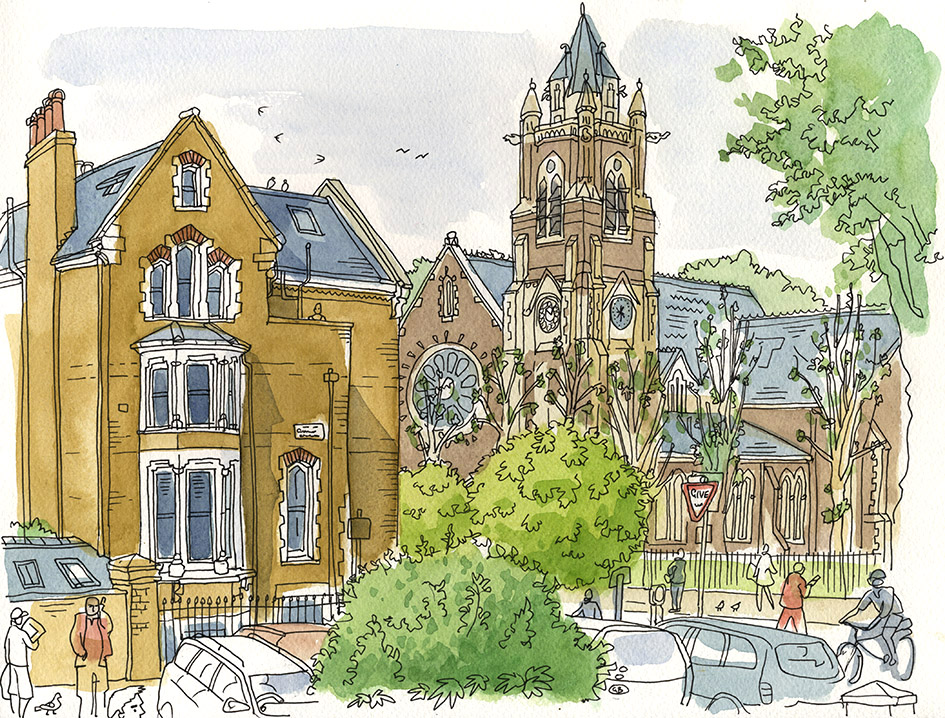
Another of my favourite streets is the well-known Brick Lane in the East End of London, where I share a studio with friends. It’s a narrow Victorian thoroughfare full of layers of colourful history, all kinds of interesting characters, shops, bars, two famous bagel bakeries and the enormous Victorian Truman Brewery, pictured below in a wood engraving, as well as a plentiful supply of Bangladeshi restaurants and cafes. The studio, on the top floor of an old building, overlooks the trains coming and going to and from Liverpool Street Station, and a combination of old industrial railway structures covered in wild greenery and swanky new developments. Independent boutiques, bookshops, vintage shops and junk stalls sit side by side. Above the hubbub of the street, the constant squeal of train brakes (which I find relaxing) and the occasional blasts music of varying quality, the studio is an oasis of light and peace. As well as the ever-changing outdoor ‘gallery’ of street art on shop shutters and walls area has layer upon layer of texture, shape and history.
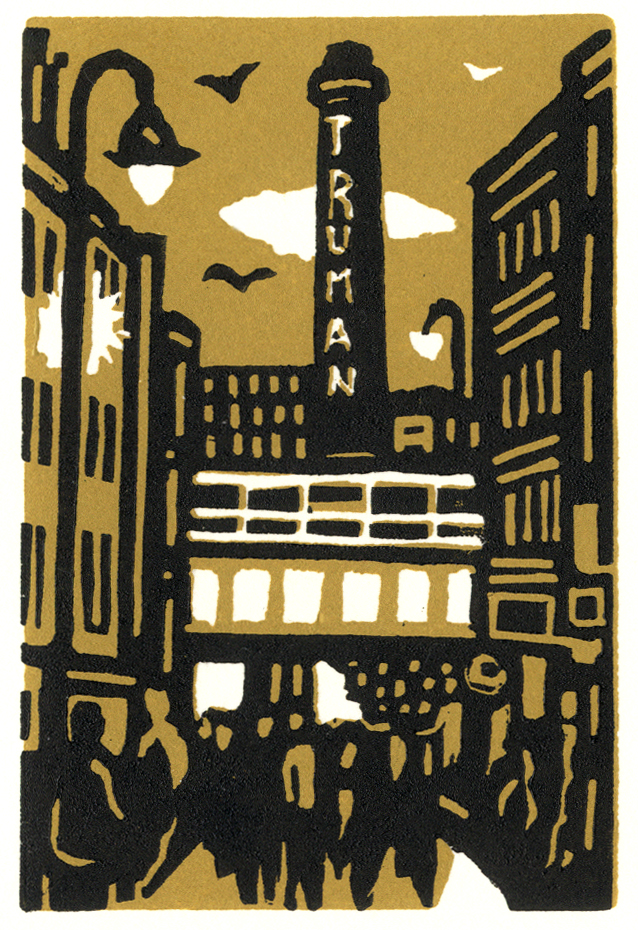
Pedestrian Space: Do different neighbourhoods in your city offer different inspiration or ‘moods’ for different type of work?
Jane: Yes, they do. I tend to feel happier when among a variety of old buildings of different shapes and sizes, especially if there are trees too. There’s something special about the combination of trees and buildings; I think it’s the contrast between organic forms and the straight lines of man-made structures. I like the inner cities for all these reasons and these areas inspire me to draw. I enjoy being in lively areas with plenty of outdoor street life, cafes, markets and independent shops; places that evolve naturally rather than by artifice.
Areas with small, interesting back streets appeal to me too. Structures built with traditional London brick, whether houses, warehouses or other buildings, make me happy too; I like the variety of soft mottled colours and ochre hues.
Being beside the Thames gives me a different feeling; a sense of spaciousness and calm, especially with the light reflected on the water. It makes me want to do bold watercolour sketches with a large brush. I do, however, try to avoid the crowds on the South Bank, as it gets very claustrophobic and I get impatient quickly.
I enjoy the atmosphere and architecture of London’s mainline railway stations too.
The sense of movement, people and trains coming and going, the grand, decorative cavernous cathedral-like quality of the buildings stimulate the senses. There’s the added exciting anticipation of journeys about to start and holidays unfolding. This drawing of King’s Cross Station was inspired by a view I snapped while cycling past one evening.
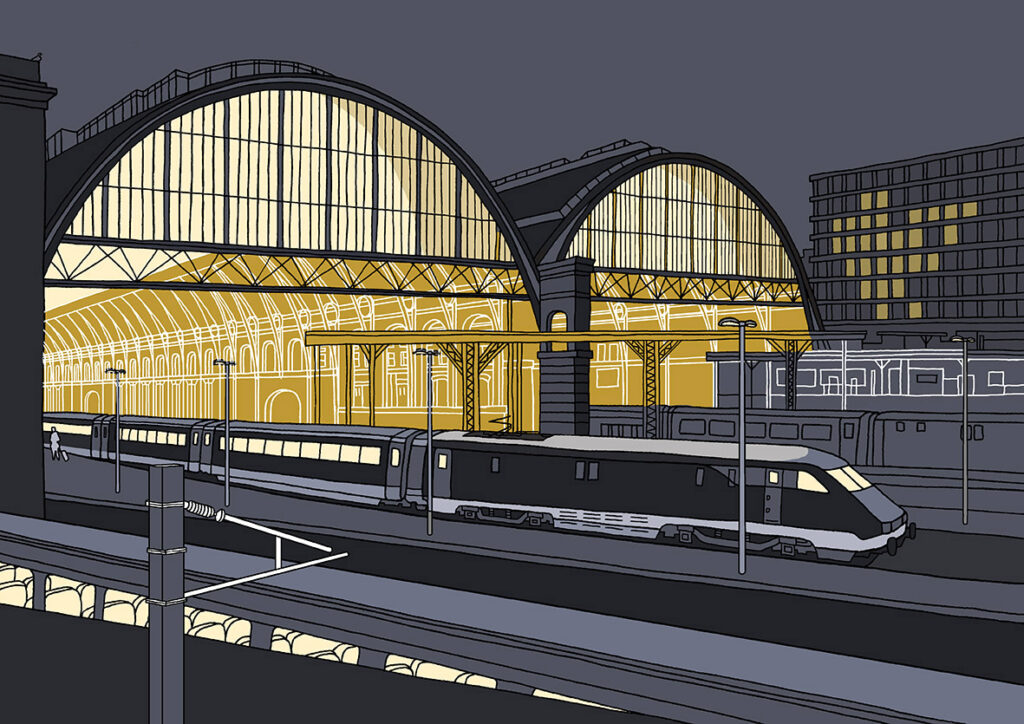
Some of the modernist estates in the city or Art Deco buildings in the suburbs interest me too from a design perspective, and still engender an atmosphere of utopian charm, spaciousness and light. Classic 1930s semi-detached houses with original features have a certain style if they haven’t been altered or modernised cheaply. This said, I can start to feel a bit insecure when I am in outlying areas or newer estates that don’t seem to hold much fascination for me. Anything fake, unless extremely kitsch or amusing, is just depressing. If there are too many chain stores, too, I begin to feel a bit empty. Although I use the supermarkets to a certain extent, I avoid large shopping centres and car-orientated retail spaces. These places are of no interest to me and if I end up in them for any reason other than by default I begin to feel a sensation of flat ennui and meaninglessness kick in quite swiftly. Give me an urban street market or car boot sale any day!
Different times of day also lend their own atmosphere to places. Morning and dusk can make even a relatively featureless area more magical, and bright evening sunlight makes everything look more dramatic. Conversely, in mid-afternoon places can appear flatter and less enticing.
Pedestrian Space: Have you done other art reflecting urban mobility?
Jane: I have worked on various other walking/cycling based maps for different organisations, usually with a historical theme. These include commissioned pieces featuring the Regent’s Canal, the King’s Cross area, the River Wandle, Lower Clapton, Hackney and South Tottenham among others. They have generally been available free to the public to encourage people to explore particular areas and keep fit.
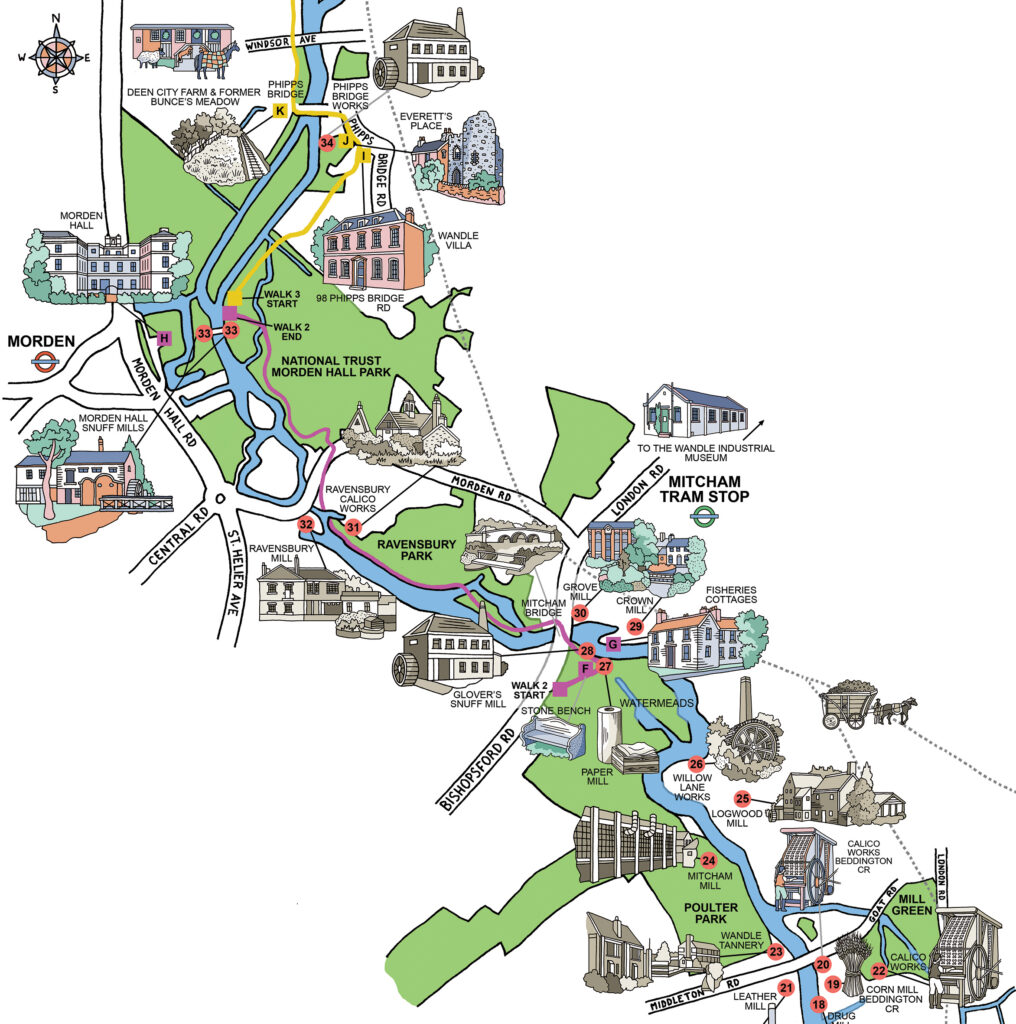
Pedestrian Space: How has the past year and effects of the pandemic affected your work in terms of process or themes or production?
Jane: At first I imagined that commissions would dwindle, but apart from one cancellation early in the pandemic, there has been a steady flow of work, and in fact my online print sales soared. I imagine that this was due to people being stuck at home in lockdown and deciding to change their decor. Sales could well have been helped also by people also wanting backgrounds for video calls.
As far as sketching creativity goes, I have missed being able to travel in Europe. I had originally planned to travel through France and Italy by train, taking my sketchbooks and visiting friends around the time the first lockdown happened. I was also due to teach sketching at an art retreat in southwest France last September but unsurprisingly all these trips had to be cancelled. Even plans to visit friends in Norwich, Sheffield and Morecambe were shelved.
Having said all that, there has been no shortage of projects to work on at home, and I have been able to use my studio in a safe, organised way with friends. Having had chance to paint, do some printmaking and organise exhibitions has been positive. The watercolour piece of Folgate Street mentioned earlier was in a group show, the Townhouse Open, in Spitalfields last September. We had an actual exhibition in the brief period between the first and second lockdowns. There is plenty to sketch locally too, and I did this one of the View from my Kitchen from my back door during the first lockdown.
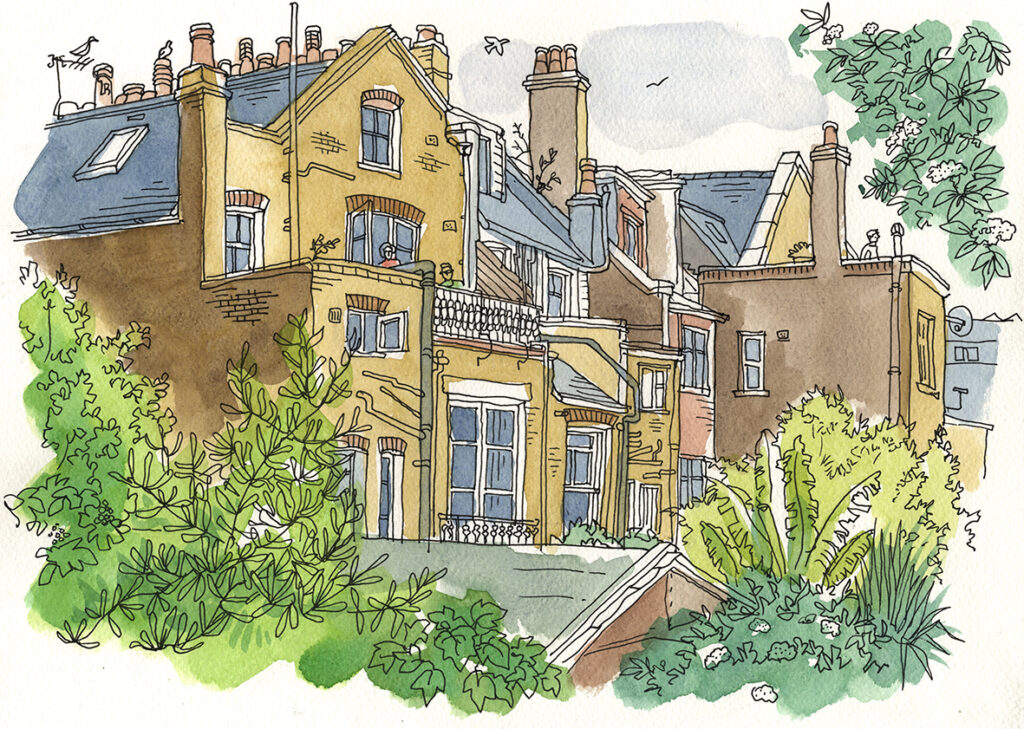
The Winter period has given me a chance to take stock of the situation and, generally, throughout the pandemic, despite the dire situation for so many, I have felt quite contented.
Visit Jane online at janeillustration.co.uk/blog, on Instagram @janeillustration and on Twitter @DalstonScribble

